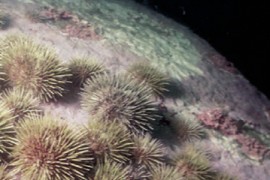Nearly Four Decades of Research Data Shows Gulf of Maine Ecosystem Not Recovering From Sea Urchin Overfishing

An ecological chain reaction triggered by the boom and bust of sea urchin fishing in the Gulf of Maine demonstrates the importance of comprehensive ecosystem-based ocean management, says a University of Maine marine scientist.
Conventional fisheries management regulates for a “maximum sustainable yield” for each managed species. However, this usually ignores strong interactions between predators and their prey that can affect the entire ecosystem, says Robert Steneck, a professor in the School of Marine Sciences at the University of Maine’s Darling Marine Center.
Steneck and three university graduates pooled 36 years of Gulf of Maine ocean data to examine how a stable ecosystem state composed of green sea urchins (Strongylocentrotus droebachiensis) and a pavement of crustose coralline algae switched, or “flipped,” to an alternate stable state dominated by erect macroalgae, or kelp and other seaweed.
When fishermen began abruptly removing large numbers of sea urchins from the Gulf of Maine in the late 1980s, the seaweed on which they grazed began to flourish, Steneck says. The abundance of seaweed, in turn, created a nursery habitat for Jonah crabs (Cancer borealis). The crabs, say the researchers, subsequently preyed on the sea urchins that remained.
The entire coastal ecosystem flipped and “locked” into a seaweed-dominated alternate stable state that has persisted for nearly 20 years.
In 2000 and 2001, Steneck and crew tried to “break the lock” of erect macroalgae by reintroducing 51,000 adult sea urchins into plots off the coast of Cape Elizabeth. But both years, large crabs migrated to the plots and wiped out the reintroduced urchins.
The consequences of sea urchin decimation “can be costly, and recovery may be difficult or impossible to achieve” for decades, Steneck says.
Fisheries management may need to focus on increasing the number of crab predators in order to return to a stable state of crustose coralline algae and sea urchins, he says.
The Gulf of Maine crab population increased in density because the seaweed nursery habitat became abundant and because, over time, commercial fishing has reduced the population of crab predators, including Atlantic cod.
Sea urchins, Steneck writes, were “highly abundant and a highly valued food” in 1987 when Maine fishermen began harvesting them along the southwestern coast before moving northeast toward Canada. The Maine harvest peaked in 1993, then declined rapidly.
In 1995, Maine’s sea urchin industry fishery was second only to that of the American lobster in value, Steneck writes. At that time, the local fishery supported more than 1,500 full-time urchin fishers.
Today, Steneck says the sea urchin fishery in the Gulf of Maine has declined 84 percent in value; no full-time fishers remain.
The study was conducted with nearly four decades of UMaine thesis research, starting with Steneck’s master’s thesis. Bob Vadas, UMaine professor emeritus, was Steneck’s thesis adviser. University graduates who co-authored the paper are Doug McNaught, assistant professor of marine ecology at the University of Maine at Machias; Amanda Leland, vice president for oceans at the Environmental Defense Fund in Washington D.C.; and John Vavrinec, senior research scientist with the Coastal Assessment and Restoration technical group at Pacific Northwest National Laboratory in Sequim, Wash.
The paper, “Ecosystem Flips, Locks, And Feedbacks: The Lasting Effects on Fisheries On Maine’s Kelp Forest Ecosystem,” is featured in the January 2013 Bulletin of Marine Science and is recommended by peer scientists on the F1000Prime website.
Contact: Beth Staples, 207.581.3777
